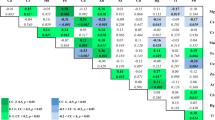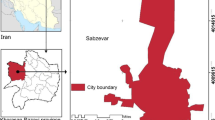Abstract
Heavy metals toxicity is a prevalent health problem particularly in developing countries. Mercury and cadmium are toxic elements that have no physiologic functions in human body. They should not be present in the human body by any concentration. Copper, on the other hand, is one of the elements that are essential for normal cell functions and a deficiency as well as an excess of which can cause adverse health effects. To test blood levels of mercury, cadmium, and copper in pregnant women in Dakahlia, Egypt. Using atomic absorption spectrophotometry, blood levels of cadmium, mercury, and copper were measured in 150 pregnant women attending to the antenatal care in Mansoura University Hospital in Dakahlia governorate, Egypt. The mean ± SD of blood mercury, cadmium, and copper levels were found to be far from their levels in the population surveys carried in developed countries like United States of America (USA) and Canada. Heavy metal intoxication and accumulation is a major health hazard. Developing countries, including Egypt, still lack many of the regulatory policies and legislations to control sources of pollution exposure. This should be dealt with in order to solve this problem and limit its health consequences.
Similar content being viewed by others
Change history
31 July 2017
An erratum to this article has been published.
References
Buse K, Hawkes S (2015) Health in the sustainable development goals: ready for a paradigm shift? Glob Health 11:13
Taylor CM, Golding J, Emond AM (2014) Lead, cadmium and mercury levels in pregnancy: the need for international consensus on levels of concern. J Dev Orig Health Dis 5(1):16–30
Borowska S, Brzóska MM (2015) Metals in cosmetics: implications for human health. J Appl Toxicol 35(6):551–572
Miyashita C, Sasaki S, Saijo Y, Okada E, Kobayashi S, Baba T, Kajiwara J, Todaka T, Iwasaki Y, Nakazawa H, Hachiya N, Yasutake A, Murata K, Kishi R (2015) Demographic, behavioral, dietary, and socioeconomic characteristics related to persistent organic pollutants and mercury levels in pregnant women in Japan. Chemosphere 133:13–21
Rana SV (2014) Perspectives in endocrine toxicity of heavy metals—a review. Biol Trace Elem Res 160(1):1–14
Kioumourtzoglou MA, Roberts AL, Nielsen F, Tworoger SS, Grandjean P, Weisskopf MG (2014) Within-person reproducibility of red blood cell mercury over a 10- to 15-year period among women in the Nurses’ health study II. J Expo Sci Environ Epidemiol. doi:10.1038/jes.2014.82
Wijesekara GU, Fernando DM, Wijerathna H, Bandara N (2015) Environmental and occupational exposures as a cause of male infertility. Ceylon Med J 60(2):52–56
Pappas RS, Fresquez MR, Martone N, Watson CH (2014) Toxic metal concentrations in mainstream smoke from cigarettes available in the USA. J Anal Toxicol 38(4):204–211
Guzikowski W, Szynkowska MI, Motak-Pochrzęst H, Pawlaczyk A, Sypniewski S (2015) Trace elements in seminal plasma of men from infertile couples. Arch Med Sci 11(3):591–598
Pollack AZ, Mumford SL, Mendola P, Perkins NJ, Rotman Y, Wactawski-Wende J, Schisterman EF (2015) Kidney biomarkers associated with blood lead, mercury, and cadmium in premenopausal women: a prospective cohort study. J Toxicol Environ Health A 78(2):119–131
Agency for Toxic Substances and Disease Registry (ATSDR) (2004) Toxicological profile for copper. U.S. Department of Health and Human Services, Public Health Service, Atlanta
Tapiero H, Townsend DM, Tew KD (2003) Trace elements in human physiology and pathology. Copper. Biomed Pharmacother 57(9):386–398
Zabihi S, Wentzel P, Eriksson UJ (2008) Maternal blood glucose levels determine the severity of diabetic embryopathy in mice with different expression of copper-zinc superoxide dismutase (CuZnSOD). Toxicol Sci 105(1):166–172
Al-Bayati MA, Jamil DA, Al-Aubaidy HA (2015) Cardiovascular effects of copper deficiency on activity of superoxide dismutase in diabetic nephropathy. N Am J Med Sci 7(2):41–46
Telianidis J, Hung YH, Materia S, Fontaine SL (2013) Role of the P-type ATPases, ATP7A and ATP7B in brain copper homeostasis. Front Aging Neurosci 23(5):44
Motawei SM, Attalla SM, Gouda HE, El-Harouny MA, El-Mansoury AM (2013) Lead level in pregnant women suffering from pre-eclampsia in Dakahlia, Egypt. Int J Occup Environ Med 4:36–44
Yahaya MI, Ogunfowokan AO, Orji EO (2011) Elemental profile in amniotic fluid of some Nigerian pregnant women. East Afr J Public Health 8(2):92–97
Pohl HR, Roney N, Wilbur S, Hansen H, De Rosa CT (2003) Six interaction profiles for simple mixtures. Chemosphere 53(2):183–197
Mokhtar G, Hossny E, El-Awady M, Zekry M (2002) In utero exposure to cadmium pollution in Cairo and Giza governorates of Egypt. East Mediterr Health J 8(2–3):254–260
Wong SL, Lye EJ (2008) Lead, mercury and cadmium levels in Canadians. Health Rep 19(4):31–36
Son JY, Lee J, Paek D, Lee JT (2009) Blood levels of lead, cadmium, and mercury in the Korean population: results from the Second Korean National Human Exposure and Bio-monitoring Examination. Environ Res 109(6):738–744
Kim YN, Kim YA, Yang AR, Lee BH (2014) Relationship between blood mercury level and risk of cardiovascular diseases: results from the fourth Korea National Health and Nutrition Examination Survey (KNHANES IV) 2008–2009. Prev Nutr Food Sci ec 19(4):333–342
Al-Saleh I, Shinwari N, Mashhour A, Mohamed Gel D, Rabah A (2011) Heavy metals (lead, cadmium and mercury) in maternal, cord blood and placenta of healthy women. Int J Hyg Environ Health 214(2):79–101
Cho S, Jacobs DR Jr, Park K (2014) Population correlates of circulating mercury levels in Korean adults: the Korea National Health and Nutrition Examination Survey IV. BMC Public Health 14:527
Murray RK, Jacob M, Varghese J (2011) Plasma proteins & immunoglobulins. In: Bender DA, Botham KM, Weil PA, Kennelly PJ, Murray RK, Rodwell VW (eds) Harper’s illustrated biochemistry, 29th edn. McGraw-Hill, New York, Chapter 50
Freeland-Graves JH, Lee JJ, Mousa TY, Elizondo JJ (2014) Patients at risk for trace element deficiencies: bariatric surgery. J Trace Elem Med Biol 28(4):495–503
Ugwuja EI, Akubugwo EI, Ibiam UA, Obidoa O (2011) Maternal sociodemographic parameters: impact on trace element status and pregnancy outcomes in Nigerian women. J Health Popul Nutr 29(2):156–162
Jung SY, Kim S, Lee K, Kim JY, Bae WK, Lee K, Han JS, Kim S (2015) Association between secondhand smoke exposure and blood lead and cadmium concentration in community dwelling women: the fifth Korea National Health and Nutrition Examination Survey (2010–2012). BMJ Open 5(7), e008218
Panhwar AH, Kazi TG, Afridi HI, Arain SA, Arain MS, Brahaman KD, Naeemullah, Arain SS (2015) Correlation of cadmium and aluminum in blood samples of kidney disorder patients with drinking water and tobacco smoking: related health risk. Environ Geochem Health
Schober SE, Sinks TH, Jones RL, Bolger PM, McDowell M, Osterloh J, Garrett ES, Canady RA, Dillon CF, Sun Y, Joseph CB, Mahaffey KR (2003) Blood mercury levels in US children and women of childbearing age, 1999–2000. JAMA 289(13):1667–1674
Ip P, Wong V, Ho M, Lee J, Wong W (2004) Environmental mercury exposure in children: South China’s experience. Pediatr Int 46(6):715–721
Hrubá F, Strömberg U, Černá M, Chen C, Harari F et al (2012) Blood cadmium, mercury, and lead in children: an international comparison of cities in six European countries, and China, Ecuador, and Morocco. Environ Int 41:29–34
Author information
Authors and Affiliations
Corresponding author
Additional information
An erratum to this article is available at https://doi.org/10.1007/s12011-017-1103-2.
Rights and permissions
About this article
Cite this article
Motawei, S.M., Gouda, H.E. Screening of Blood Levels of Mercury, Cadmium, and Copper in Pregnant Women in Dakahlia, Egypt: New Attention to an Old Problem. Biol Trace Elem Res 171, 308–314 (2016). https://doi.org/10.1007/s12011-015-0525-y
Received:
Accepted:
Published:
Issue Date:
DOI: https://doi.org/10.1007/s12011-015-0525-y




